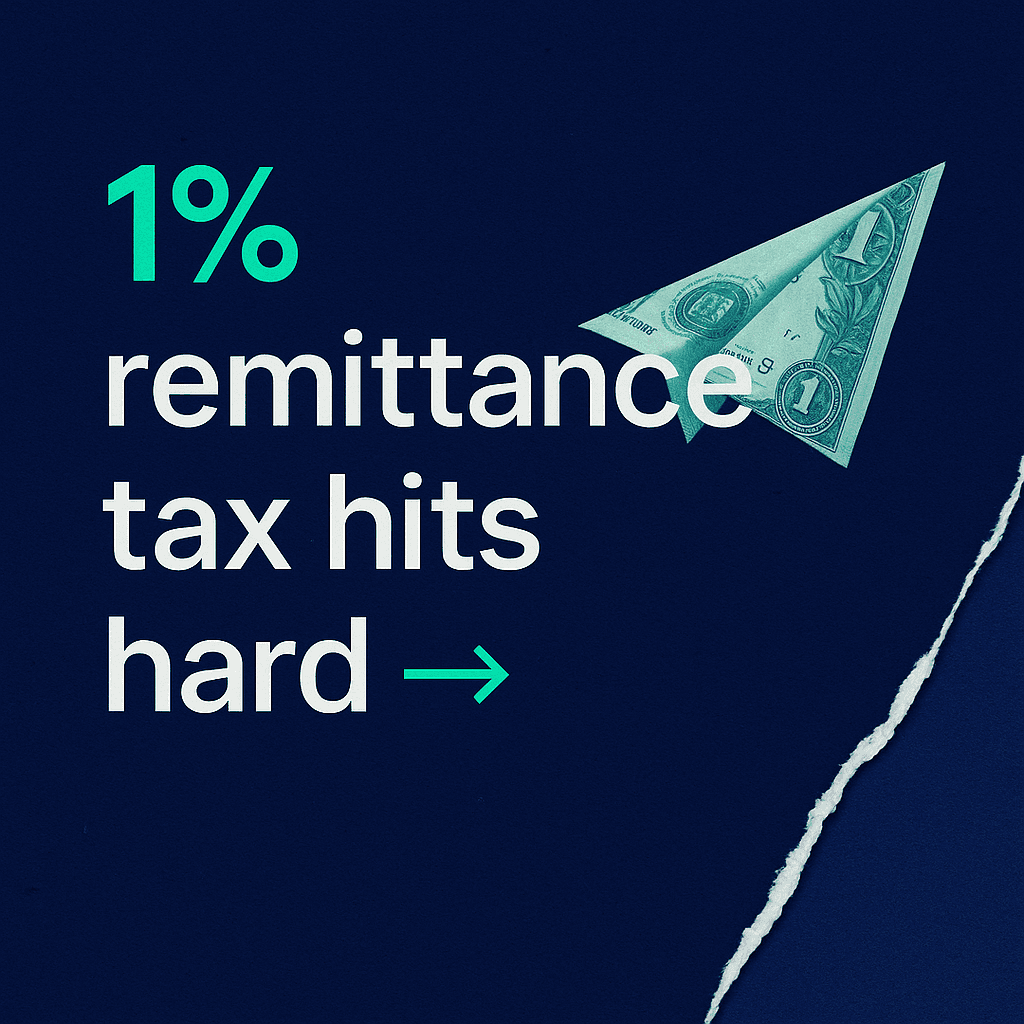Topic
B2B Commerce
Published
August 2025
Reading time
3 minutes
Accelerating the shift to stablecoins
The potentially unintended impact of the One Big Beautiful Bill Act
Accelerating the shift to stablecoins
Download ArticleResearch

On July 4, 2025, President Trump signed the One Big Beautiful Bill Act, which includes a new 1% federal excise tax on certain outbound remittances. The tax applies to transfers funded with cash, money orders, cashier’s checks, or similar instruments, while bank-account and card-funded transfers are exempt. Earlier drafts proposed higher rates (3.5%–5%) and different scopes, but the final version settled at 1%. The broader package relies on immigrant- and visitor-focused fees to help fund enforcement priorities.
Why Does This Matter?
The new 1% remittance tax functions less as a revenue engine and more as a friction shock to U.S.-origin corridors – particularly Mexico and other LATAM countries where price sensitivity is high and cash channels are common. The US has consistently been the top remittance-sending country with total outflow of $93 billion in 2024.1 Of that, approximately $62 billion went to Mexico, accounting for 96.6% of the country’s total remittance inflows.2
By raising costs on cash-funded transfers, there is a real incentive to push senders off formal rails and into informal or crypto routes–weakening transparency, AML/KYC controls and receive-side FX liquidity. The Center for Global Development (CGD) estimates that a 1% price increase will lead to a ~1.6% drop in formal remittances, implying outsized losses in big corridors in countries where remittances are a large share of GDP.3
The law’s cash-only scope also skews the burden toward senders who rely on money-transfer operators–often unbanked or underbanked individuals who face a “cash payout premium.” Policymakers should anticipate softer household consumption and slower micro-investment as a result. The response will likely be to cut domestic fees and expand digital rails.
From Cash To Crypto
The tax incidence will reshape corridor economics. A likely knock-on effect of the U.S. remittance tax is a possible shift to stablecoin rails. Stablecoins already account for a large share of global on-chain activity and are increasingly used for cross-border payments. In 2024, stablecoins processed $27.6 trillion in transactions, surpassing Visa and Mastercard’s combined transaction volume by 7.68% .4 This rapid adoption signals that stablecoins are no longer just an alternative; they are becoming the preferred method for cross-border payments and financial transactions.
Industry data points to 2025 as a breakout year for stablecoins in cross-border flows, with major remittance players (e.g., MoneyGram) enabling USD coin (USDC) cash-in/cash-out at retail locations. Pegged to assets like the U.S. dollar, stablecoins eliminate volatility, ensuring the amount sent is the amount received. Unlike slow, costly traditional remittances, stablecoins enable near-instant, low-fee transfers, providing diasporas a reliable and affordable way to send money home. Transaction fees are often less than half those of traditional rails.5 We expect to see providers steering banked customers toward compliant, account-based stablecoin corridors. Regulators will have to weigh the efficiency gains against AML/KYC risks associated with rapid on-chain adoption.
The Rails Race Is Only Just Beginning
This 1% levy is less a revenue policy than a routing policy: it will push U.S.-origin cash corridors toward whichever rails minimize friction most efficiently. Whether that shift strengthens the formal system or hollows it out will depend on the speed of credible, compliant digital alternatives, especially account-based stablecoin corridors with cash-in/cash-out at the edge. If providers can migrate a meaningful slice of cash senders before the tax comes into effect, volumes will remain formal; if not, expect leakage to informal and lightly supervised channels.
Have a different opinion on how the remittance tax will play out? Please reach out, we’d love to hear from you!
Endnotes
[1] Lucidity Insights, The Role of Remittance Outflow Countries 2024 in Global Financial Support, 2025
[2] BBVA Research, Mexico: Record in remittances, 2025
[3] CGD, Even At 1% The US Remittance Tax Hits Poor Countries Hard, 2025
[4] Lisk, Breaking Borders: How Stablecoins Are Replacing Traditional Remittances, 2025
[5] Pymnts, Cross-Border Payments Cost Could Be Cut by Blockchain, 2024
The information contained herein is provided for informational purposes only and should not be construed as investment advice. The opinions, views, forecasts, performance, estimates, etc. expressed herein are subject to change without notice. Certain statements contained herein reflect the subjective views and opinions of Activant. Past performance is not indicative of future results. No representation is made that any investment will or is likely to achieve its objectives. All investments involve risk and may result in loss. This newsletter does not constitute an offer to sell or a solicitation of an offer to buy any security. Activant does not provide tax or legal advice and you are encouraged to seek the advice of a tax or legal professional regarding your individual circumstances.
This content may not under any circumstances be relied upon when making a decision to invest in any fund or investment, including those managed by Activant. Certain information contained in here has been obtained from third-party sources, including from portfolio companies of funds managed by Activant. While taken from sources believed to be reliable, Activant has not independently verified such information and makes no representations about the current or enduring accuracy of the information or its appropriateness for a given situation.
Activant does not solicit or make its services available to the public. The content provided herein may include information regarding past and/or present portfolio companies or investments managed by Activant, its affiliates and/or personnel. References to specific companies are for illustrative purposes only and do not necessarily reflect Activant investments. It should not be assumed that investments made in the future will have similar characteristics. Please see “full list of investments” at https://activantcapital.com/companies/ for a full list of investments. Any portfolio companies discussed herein should not be assumed to have been profitable. Certain information herein constitutes “forward-looking statements.” All forward-looking statements represent only the intent and belief of Activant as of the date such statements were made. None of Activant or any of its affiliates (i) assumes any responsibility for the accuracy and completeness of any forward-looking statements or (ii) undertakes any obligation to disseminate any updates or revisions to any forward-looking statement contained herein to reflect any change in their expectation with regard thereto or any change in events, conditions or circumstances on which any such statement is based. Due to various risks and uncertainties, actual events or results may differ materially from those reflected or contemplated in such forward-looking statements.

